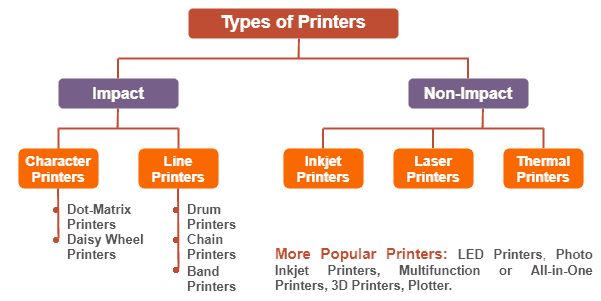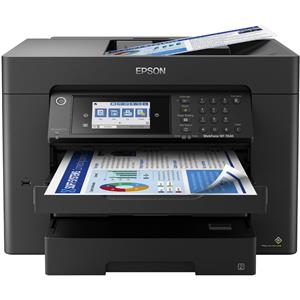Deep Dive Into Printer Technology: The Two Main Types of Printers
Introduction
Nowadays, whether it's for professional or personal use, printers provide a crucial function in our lives. This article vanquishes the confusion about the two main types of printers available in the market - Inkjet and Laser printers. We delve into how they function, what differentiates them, and how to choose the most suitable one for your needs. This thorough comparison will equip you with the essential knowledge making your printer-purchasing decisions easier.
What Are the Two Main Types of Printers?
In the vast landscape of printing technology, two types of printers come out on top and are most prevalently used - Inkjet and Laser printers. Both these printers exhibit unique characteristics, making them suitable for different use scenarios.
• Inkjet Printers - Renowned for their versatility, these printers are commonly found in home environments. They are excellent at printing everything ranging from standard texts to high-definition photos, boasting impressive detail and color accuracy.
• Laser Printers - Admired for their high speed and precision, Laser printers are the go-to option for heavy-duty printing tasks, such as printing large volumes of documents. Owing to these attributes, they are typically preferred in corporate or business settings.
Hence, when you're at a crossroads trying to decide which printer to buy, identifying your requirements and matching them with the strongest attributes of these two types can ease your decision-making process.
Inkjet Printers: What Are They and How Do They Work?
Inkjet printers, quite self-explanatory from its name, depend on ink to accomplish their printing tasks. When a command to print is relayed to the printer, it processes the command by transforming the text or image into minuscule dots. The printer then takes these dots and, using its ink-dispensing nozzles, projects them onto the paper. One of their key attributes is the ability to produce colorful, highly detailed, and smudge-resistant photos.
Let's delve into the working mechanism of an Inkjet Printer:
- The primary step involves the translation of data (text, image, etc.) into tiny dots, streamlining the further printing process.
- These dots are then translated to the paper using the printer's inbuilt nozzles that spray out ink.
- Inkjet printers revolve around the use of four principal colors for its prints: cyan, magenta, yellow, and black, better known as CMYK.
- Depending on the specific color requirements of the print, these colors can combine in various proportions.
The true allure of an inkjet printer is brought out by its ability to generate a preset variety of hues that can bring photos to life. This is achieved using the CMYK color system which enables them to capture a wide spectrum of colors leading to rich, highly-detailed photos.
It's worth noting that although Inkjet printers have slower printing speeds compared to their laser counterparts, this is compensated with their quality output, particularly for colored images. Offering colorful spectacle, inkjet printers carve their niche.
Laser Printers: What Makes Them Different?
Laser printers communicate intricate complexities in their technique for creating prints. They harness the power of a laser beam to create prints by tracing electronically charged patterns onto a drum within the printer itself. These patterns then attract toner powder forming their shape, which is subsequently transferred onto paper and melted to produce the finished print.
Unlike their Inkjet counterparts, laser printers may not be the champions of color diversity or photo efficiency. However, their speed, precision, and volume output set them apart and make them a desirable tool in business environments.

Here's a look at the distinguishing features of laser printers:
1. Printing Technique: Embraces laser technology, using a laser beam to form patterns which in turn attract the toner powder. This powder is then transferred and melted onto the paper to create the final print.
2. Versatility: Ideal for text-centric prints but not as proficient for colored or photo prints.
3. Speed: Superior when it comes to speed, laser printers enable rapid and large volume printing, catering to high demand environments.
4. Precision: Boasts high precision printing, rendering crisp, clear text.
5. Volume: Impressive volume output caters to corporate and business environments that demand frequent, high quantity printing.
6. Cost: Although they have higher upfront costs, the toner used in laser printers often lasts longer leading to lower running costs, especially in heavy use scenarios.
In summary, laser printers are a go-to choice for businesses and corporate environments where speed, precision, and high-volume printing are essential facets.
How to Choose Between an Inkjet and Laser Printer?
The eventual choice between an Inkjet and a Laser printer is fundamentally influenced by your individual demands and printing preferences. Understanding the distinct attributes of both printers, their appropriate circumstances, as well as the cost factors involved, are essential steps towards an informed decision.
Here's a simplified breakdown that might aid in your quest in finding the perfect printer:
- Primary Purpose: Inkjet Printer
If your printing needs majorly revolve around producing high-resolution photographs alongside a variety of print media, an Inkjet printer should be your choice. Their exceptional capability to deliver richer colors and intricate details redefines the standard for print quality.
- Primary Purpose: Laser Printer
If you typically deal with text documents, particularly in large quantities, a Laser printer will likely be a more efficient tool. Renowned for their high-speed outputs, they deliver crystal clear, sharp text, thus making them a prevalent choice in corporate environments.
Beyond these comparative factors, you should also consider the cost elements.
- Cost Factor: Inkjet Printer
Inkjet printers have the edge when considering the initial price as they are generally cheaper upfront than their counterparts. However, they can be costlier in the long run due to potentially high ink cartridge expense.
- Cost Factor: Laser Printer
Unpacking the cost dynamics of a Laser printer, you'll discover a higher initial purchase price which could be quite substantial. However, the reduced running costs due to affordable toner cartridges might offset this disadvantage, especially in high usage scenarios.
In essence, the choice between an Inkjet and Laser printer revolves mainly around the balance between your specific printing needs and the cost factor. Whether you frequently print vibrant photographs or require high-speed text documents, considering these points will enable you to invest wisely in a printer that best suits your requirements.
Inkjet Versus Laser Printers: A Comparative Analysis
When deliberating between an Inkjet and Laser printer, it's essential to understand the unique strengths and weaknesses of each. By examining these differences, you can determine which type of printer best suits your specific printing needs.
A comparison of the key differences between Inkjet and Laser printers:
Inkjet Printers
- *Quality:* Exceptional at producing high-quality color photos and images.
- *Print Speed:* Relatively slower than lasers.
- *Cost:* Typically cheaper to buy but maintaining and replacing ink cartridges can be expensive, especially if you print a lot.
- *Best For:* Home users, photographers, or any occupations requiring high-quality color prints and casual use.

Laser Printers
- *Quality:* Excellen for text prints, producing crisp and clean lines. However, can struggle to produce high-quality color images.
- *Print Speed:* Faster print speeds, ideal for high volume prints.
- *Cost:* Higher initial purchase cost but relatively cheaper to maintain. Toner replacements are not as frequent which makes them economical for heavy use.
- *Best For:* Business use and environments that require fast, high-volume text printing such as offices or schools.
While both types of printers have their own set of advantages, your personal or business-specific requirements should take precedence when choosing. An important point to remember is that initial cost should not be the only factor influencing your decision. Rather consider the long-term maintenance costs, print quality, speed, and your print volume when making your choice. Each printer excels in certain areas and knowing your needs will guide you to the best fit.
Conclusion
In conclusion, both Inkjet and Laser printers offer unique advantages. Your choice depends greatly on what you need from a printer. Generally, for high-quality photo prints and versatile use, go for an inkjet. For volume, speed, and efficiency in printing text documents, choose a laser printer.
Related FAQs about what are the two main types of printers
What are the main differences between inkjet and laser printers?
Inkjet printers use liquid ink which is sprayed onto the paper through microscopic nozzles, producing high-quality photos and images. Laser printers use powdered toner, applied via an electrostatic charge, then melted by heat onto the paper. They excel in high-speed and high-volume print tasks, particularly texts.
Which type of printer is right for my needs?
The choice depends on your specific needs. If you print high-quality photos or work with various print media, an inkjet printer would be suitable for you. If you require high-volume, text-centric prints with speed and precision, a laser printer would serve better.
What are the advantages and disadvantages of both printer types?
Inkjet printers offer superior photo print quality and color vibrancy, but they have slower print speeds and the ink can be costly. Laser printers provide high-speed, high-volume, and precise text printing, although their initial cost is higher and they may not reproduce color images as accurately as inkjets.


